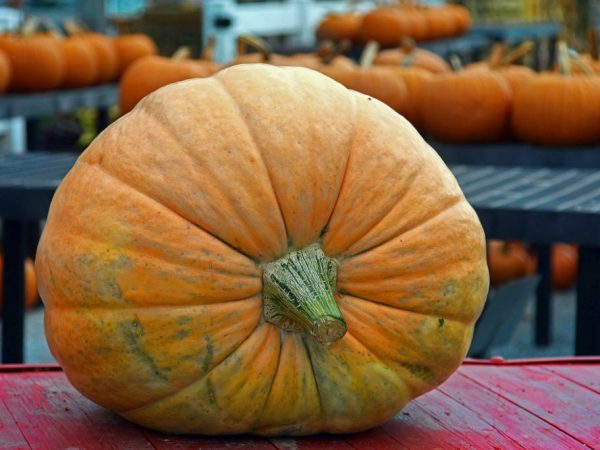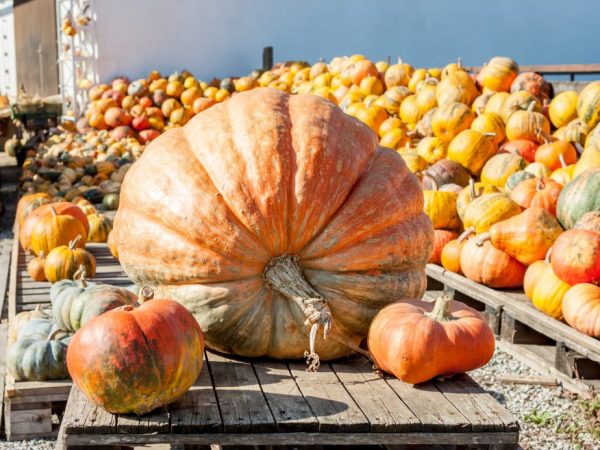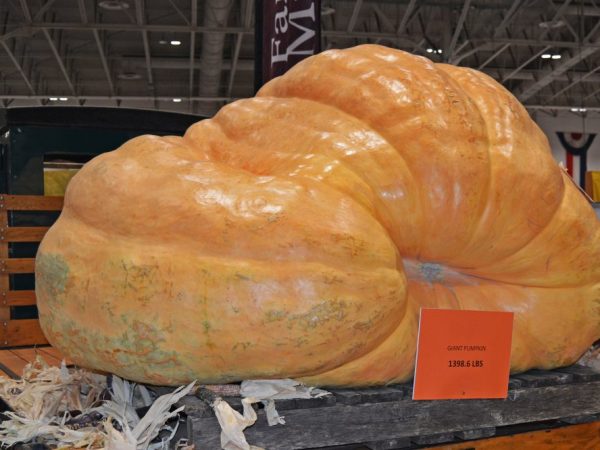How to grow the biggest pumpkin
Everyone knows about the biological value of pumpkin crops. If you follow the planting and grooming guidelines, growing a large pumpkin is a snap. It takes a little more effort than usual, but the result is worth it.

How to grow the biggest pumpkin
Necessary growing conditions
Pumpkin culture is thermophilic. It will germinate when the air temperature reaches 14-16 ° C.
If conditions are favorable, the first shoots will form a week after planting the seeds. The growth and development of bushes is activated at an ambient temperature of 20-25 ° C.
The pumpkin seeds cannot be kept in cold water for a long time. This can provoke the appearance of weak seedlings, undeveloped bushes and low yield rates.
The plant requires the most heat during the growth and flowering phase, so plantings are located from the southern part of the garden, where more sunlight gets.
An additional stage is to cover the beds with foil. It is better to cover the plants in the evening, and clean them during the day to improve air exchange in the root system.
Compatibility with other cultures
You can plant a pumpkin after legumes or cabbage varieties. Garlic and onion do not reduce soil fertility, which is ideal for pumpkin varieties.
Cannot be planted after carrots or late cabbage, because these vegetables take all the nutrients from the soil.
High compatibility of pumpkin with the following plants:
- corn;
- tomatoes;
- beans;
- peas.
The space between the rows is filled with nasturtium or mint. Due to its fragrant properties, these flowers will destroy all parasites that have settled in the ground.
Potatoes are not planted next to the pumpkin, because it is exposed to a large number of pests and diseases.
Soil selection

The light and the sun are doing their job
To grow a huge pumpkin, give preference to light areas that do not shade other plants. The cultivation of this culture is carried out in places warmed by the sun's rays every day.
Choose a place on a hill so that moisture does not accumulate and stagnate in the soil, otherwise it will provoke rotting of the root system.
Pumpkin prefers to grow on sandy loam soils that are rich in organic matter and humus. High yields are noted when planting in chernozems.
Do not plant in heavy soil, because it dries badly.
It is forbidden to plant a crop on sparse sandy soils: they will provoke drying out of the bushes if watering is infrequent.
If your area is dominated by peat or sandy soils, you will have to apply 40 kg of humus, clay and turf per 1 m² every year. The optimum acidity for this plant is 6%.
Seed selection
To grow a large pumpkin, seeds are selected that meet the requirements of the gardener.
- Almond. This variety is notable for the fact that the fruits reach 7 kg. Climbing bushes, with medium ripening.The first vegetables ripen 120 days after planting. The pulp in the fruit is fleshy, orange.
- Table grade Zorka. The surface of the pumpkin is gray-green. The pulp is orange, with a high sugar content. Average weight - 5 kg. This variety is popular due to the presence of carotene in its composition. It is grown on industrial sites, so that later to create a puree for children.
- Volzhskaya. A table variety that matures 110 days after planting outdoors. They are planted at a great distance, since it has long lashes. Fruits with a gray skin. Their shape is flattened, rounded. Each one reaches a weight of 9 kg. The composition has a minimum sugar content, therefore it is used for the preparation of preserves. This species is drought tolerant and suitable for long-term storage.
- The fruits of the Kherson pumpkin grow up to 10 kg in weight. Bushes do not weave much. Since plants send all the nutrients to the ovary, and not to growth, the fruits grow large. Ripening dates are late, so the harvest is harvested at the end of October. The peel is gray shiny color. Keeping quality is good, up to 4 months.
Landing technology
Planting pumpkins is carried out both by seeds and seedlings. Let's consider each separately.
Seed method
Seeds are planted in spring when the soil temperature is between 10-14 ° C. Prepare the beds, then you can start the procedure.
- Dig up the soil.
- Dig holes 5 cm deep.The distance between them should be 60 cm, and the row spacing should be 2 m.
- Pour 2 kg of humus, 250 g of ash and 30 g of nitrophoska into the hole.
- Mix the contents of the pit and pour 3 liters of manganese solution (3 tablespoons of manganese per 5 liters of water). This will decontaminate the soil and reduce the risk of disease.
- Place 3 seeds in the hole to increase the chances of friendly shoots.
- If all the seedlings have appeared, no more than 3 seeds are left in the hole.
- If there is a risk of frost, the beds are covered with plastic wrap. This will create optimal conditions for active growth. At lunchtime, the film is removed so that the plant is saturated with oxygen.
Seedling method
For each seedling, a pit is prepared, the depth of which will be 10-12 cm. A distance of 1 m is left between the seedlings, and 2 m between the rows. Such a distance is necessary, since the pumpkin belongs to climbing crops.
A few hours before planting, 3 kg of compost is poured into the hole and 5 liters of warm water are poured into it.
Seedlings are placed vertically inside the pit and sprinkled with earth tightly. For the first 7 days, a cardboard cap is put on each plant to protect it from night frosts.
When planting, the seedlings are taken out of a plastic glass, trying not to damage the roots and placed in a hole. Seeds are planted a month before transplanting seedlings into open ground.

It's easy to grow a pumpkin
Care
Pumpkin belongs to tropical plants, so it needs quality care to protect it from freezing. You will have to pollinate the bushes yourself if there are not enough male inflorescences on them.
For these purposes, squash is used. When the fruits are formed, remove any large leaves so that the pumpkin can grow under the influence of the sun.
To reduce the risk of rotting, wooden boards are placed under the vegetables. This will keep the pumpkin out of contact with the soil.
Loosen the soil regularly so that air and nutrients can enter the roots, and removing weeds will provide reliable protection from pests.
Watering
Try to water at least 2-3 times a week. Drought leads to a decrease in yield and marketability of products.
Reducing watering is allowed only during the flowering period of the bushes.
For irrigation, use only water with a temperature of 20-25 ° C. Pour no more than 5 liters under each bush so as not to provoke stagnation of moisture in the ground.
Top dressing
It is allowed to bring rotted manure or ammonium nitrate in the first few weeks of the plant's growing season. Further feeding with these substances provokes an increase in green mass, which leads to rare ovaries.To feed the pumpkin, use 1 kg of chicken manure, which is dissolved in 5 liters of warm water.
For sweetness and good taste, add potash to the soil. If it is possible to buy potassium nitrate, 300 g of the substance is dissolved in 10 liters of water. Replace this fertilizer with 2 cups of wood ash, which is mixed with 10 liters of water. Other, no less effective potash elements include:
- humate (500 g per 10 l of water);
- potassium sulfate (200 g per 10 liters of water).
Topping
The necessary process is pinching. First, cut off all the shoots, leaving only 3. On the main stem, no more than 5 ovaries should remain, the diameter of which is 10 cm. The minimum number of ovaries contributes to the formation of large fruits.
After tying the first pumpkin, pinch the whip located above it. If this is not done, this will lead to the formation of an additional ovary and the formed small fetus will stop developing.
Disease protection
You can get the largest pumpkin if you protect it from diseases and pests.
This culture is often invaded by bacteria, fungi or parasites, so you need to know not only how to deal with them, but also preventive measures.
- Bacteriosis often develops on the surface of pumpkin bushes. This disease manifests itself in the form of brown spots, which eventually become ulcers on the leaves. To prevent the development of bacteriosis, protect the plantings from temperature extremes and high humidity levels. Bordeaux liquid (30 g per 5 liters of water) or zinc sulfate (100 g per 10 liters of water) is considered an effective means of struggle.
- White rot is a fungal infection. Symptoms of this disease are white bloom, which is located on foliage and fruits. If you do not start treatment, the bushes will rot. Spraying with Epin (40 g per 2 liters of water) helps to protect the beds from white rot. They fight it with copper sulfate (20 g per 10 liters of water) or charcoal (200 g of coal are crushed and the powder is mixed with 5 liters of water).
- Root rot. The reasons for the development of this disease are considered to be incorrect frequent watering and the lack of loosening of the beds. It is impossible to eliminate the signs of root rot. All that can be done is to remove the decayed parts and sprinkle the remaining roots with soil.
- Powdery mildew appears as white spots on the leaves. Over time, the foliage dries up and yields decrease. Prevention consists of removing weeds and digging the area annually. The fight is based on the use of colloidal sulfur (30 g of powder per 10 liters of water) or isophorone (10 capsules per 5 liters of water).
Getting rid of pests
Of the pests, spider mites and melon aphids are often found.
- The presence of a white cobweb around the leaves helps to determine the appearance of a spider mite. A solution of onion peels (100 g per 10 l of water) helps to fight this parasite. The mixture is infused for 3 days, after which spraying is carried out.
- A sign of the appearance of melon aphids is twisting and drying of the foliage. To eliminate this parasite allows a solution of karbofos (100 g per 10 liters of water). Processing is carried out every week.
Prevention of any pests consists in loosening the soil and removing weeds in the beds.
Summing up
Growing the largest pumpkin in the country is within the power of every gardener. It is enough to have a desire and know the basic principles of planting and caring for a crop.
Spending a minimum amount of time to ensure the necessary conditions for growth, in the fall you will enjoy beautiful and tasty fruits.
If you plant varieties that are stored for a long time on your site, you will feast on the products until mid-winter.

